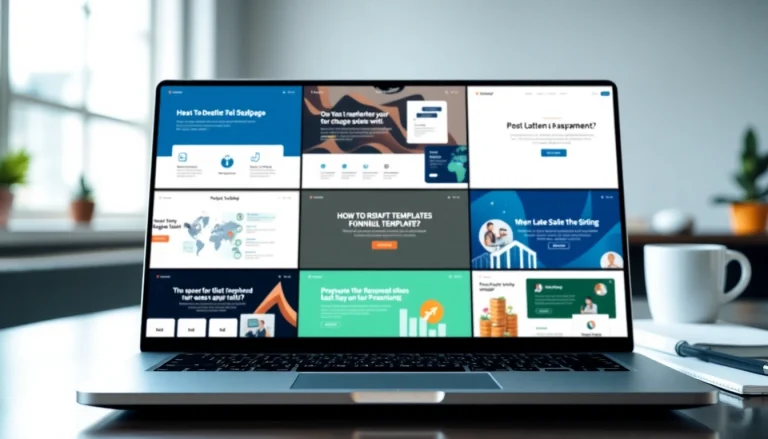
Understanding Market Research Data Collection
Defining Market Research Data Collection
Market research data collection is the systematic process of gathering information regarding consumers’ preferences, behaviors, and attitudes related to a business’s product or service. This process is essential for organizations looking to gain a comprehensive understanding of their target market. It involves both qualitative and quantitative data, enabling companies to make informed decisions that align with consumer needs. Essentially, market research data collection helps businesses evaluate the strategies for their products, marketing efforts, and overall brand positioning.
Importance of Data in Business Decisions
Data-driven decision-making has become a cornerstone for business success in today’s competitive landscape. The information collected during market research aids in strategic planning, product development, and marketing campaigns. It allows organizations to:
- Identify Market Trends: Recognizing emerging trends helps businesses stay ahead of the curve.
- Understand Consumer Needs: By comprehending what consumers want, businesses can tailor their offerings accordingly.
- Reduce Risk: Market research minimizes uncertainties associated with launching new products or entering new markets.
- Enhance Customer Satisfaction: Feedback gathered can lead to improved products and services, fostering better customer relationships.
This reliance on data ultimately fosters a more agile and responsive business environment, where companies can adapt quickly to changes in consumer sentiment and market dynamics.
Types of Data Collected in Market Research
In market research, data can be classified into two main categories:
- Quantitative Data: This data type is numerical and can be analyzed statistically. It often includes metrics such as sales numbers, market share percentages, and survey results that allow for mathematical analysis.
- Qualitative Data: This encompasses non-numerical information, such as customer opinions, feelings, and motivations. It is often derived from interviews, focus groups, and open-ended survey questions, providing deeper insights into consumer behavior.
Both data types are crucial in developing a nuanced understanding of the market landscape.
Common Methods for Data Collection
Surveys: A Key Tool for Data Gathering
Surveys remain one of the most popular and effective methods for collecting data in market research. They can be distributed in various formats, including online, telephone, and face-to-face. Surveys can target specific demographic groups and gather a wide range of information. Key considerations include:
- Question Design: Questions should be clear, unbiased, and targeted to obtain the specific information needed.
- Sample Size: A larger sample size leads to more reliable results, representing the target market effectively.
- Distribution Method: Choosing the right platform (e.g., email, social media, or face-to-face) can significantly impact response rates.
Employing these considerations can enhance the effectiveness of surveys, yielding actionable data.
Utilizing Focus Groups in Market Research
Focus groups allow researchers to gain qualitative insights by engaging directly with potential consumers. This method typically involves a moderated discussion among a small group of participants who provide feedback on a product, concept, or advertisement. Some advantages of focus groups include:
- In-Depth Understanding: Participants can elucidate their thoughts and feelings in a way that numbers alone cannot convey.
- Diverse Perspectives: A variety of participants can provide insights that reflect differing consumer segments.
- Interactive Format: The group dynamic facilitates a deeper exploration of ideas as participants build off each other’s contributions.
Despite their benefits, focus groups require careful moderation to ensure all voices are heard and to prevent dominant personalities from skewing the data.
Observation Techniques for Insightful Data
Observation is a qualitative research method that involves watching how consumers interact with products or services in real time. This method can be conducted in various settings, such as stores, online platforms, or events. Key aspects include:
- Natural Environment: Observing consumers in their natural settings can yield authentic insights about their behaviors and preferences.
- Non-Intrusive Approach: When done correctly, observation does not interfere with the consumer’s experience, leading to more genuine reactions.
- Behavior Tracking: This technique allows researchers to gather data on behaviors that consumers may not even consciously recognize or articulate.
Although it can be resource-intensive, observation is invaluable for understanding real-world consumer interactions.
Best Practices for Conducting Market Research
Planning and Designing Effective Research
A well-thought-out research plan is essential for successful data collection. This involves setting clear objectives, defining the target audience, selecting appropriate data collection methods, and establishing timelines. Fundamental steps include:
- Identifying Objectives: What specific questions does the research seek to answer?
- Selecting Methodologies: Choose methods that align best with your objectives and audience.
- Recruiting Participants: Ensure a diverse participant pool that represents your target audience.
- Setting a Timeline: A well-structured timeline helps maintain productivity and accountability throughout the research process.
This meticulous groundwork can enhance the quality and reliability of the research outcomes.
Data Collection: Ethical Considerations
Ethics in data collection is paramount. Researchers must respect participant confidentiality and obtain informed consent. Key ethical considerations include:
- Transparency: Clearly communicate the purpose of the research and how the data will be used.
- Voluntary Participation: Participants should be free to withdraw at any time without repercussion.
- Data Protection: Implement measures to safeguard the privacy of participants, adhering to regulations such as GDPR.
Maintaining ethical standards not only ensures compliance but also fosters trust between researchers and participants, which is critical for the integrity of the study.
Analyzing Collected Data for Actionable Insights
Data analysis is where raw information is transformed into actionable insights. It typically involves cleaning the data, selecting analysis methodologies, and visualizing the results. Practical steps include:
- Data Cleaning: Remove duplicates, correct errors, and format the data for analysis.
- Choosing Analysis Techniques: Depending on the data type, choose appropriate methods such as statistical analysis for quantitative data or thematic analysis for qualitative data.
- Visualization: Use graphs, charts, and dashboards to present findings clearly to stakeholders.
Effective data analysis not only sheds light on consumer behaviors and preferences but also aids in forecasting market trends and guiding business strategies.
Challenges in Market Research Data Collection
Overcoming Bias in Data Gathering
Bias can occur at various stages of data collection, jeopardizing the validity of the research findings. Common biases include selection bias, response bias, and confirmation bias. Strategies to minimize bias involve:
- Diverse Sampling: Ensure that the selected sample accurately represents the population.
- Neutral Question Design: Craft questions that elicit unbiased responses.
- Using Multiple Methods: Triangulate data from different sources to reduce the impact of bias inherent in any single method.
Addressing these biases is critical for producing credible and reliable market research findings.
Dealing with Incomplete or Inaccurate Data
Data integrity is essential in market research. Inaccurate or incomplete data can lead to misguided decisions. Best practices for dealing with such issues include:
- Quality Assurance Processes: Implement checks at each stage of data collection to ensure accuracy.
- Effective Training: Train personnel on data collection techniques to minimize human errors.
- Continuous Monitoring: Regularly review data collection processes and outputs for potential issues.
Enhancing data quality strengthens the foundation for informed decision-making.
Mitigating Costs Associated with Research
Market research can be an expensive endeavor, but several strategies can help manage costs without compromising quality:
- Utilizing Cost-Effective Tools: Leverage technology such as online survey platforms, which often provide undervalued capabilities at lower costs.
- Focusing on Specific Objectives: Narrowing down research goals allows for a more targeted and efficient use of resources.
- Collaborating with Educational Institutions: Partnering with universities for research projects can reduce costs while providing students with practical experience.
Effective cost management ensures that businesses can invest strategically in market research while obtaining valuable insights.
The Future of Market Research Data Collection
Emerging Technologies and Their Impact
The field of market research is rapidly evolving with the introduction of new technologies and methodologies. Innovations such as AI-driven analytics, big data, and machine learning contribute to more sophisticated data collection and analysis techniques. These technologies enable:
- Real-Time Data Collection: Instantaneous feedback allows businesses to adapt quickly to consumer trends.
- Enhanced Predictive Analysis: AI models can forecast outcomes based on past data patterns, helping businesses strategize effectively.
- Improved Personalization: Data collected can be utilized to craft personalized marketing experiences for consumers.
As technology advances, the nature of market research will change, emphasizing agility and responsiveness.
Adapting to Consumer Behavior Changes
Consumer behavior is continuously changing; therefore, market research must keep pace. The rise of digital platforms, social media, and e-commerce is transforming how consumers interact and express their preferences. Adapting to these shifts means:
- Monitoring Digital Engagement: Tracking online behaviors can reveal consumer interests and emerging trends.
- Emphasizing Experience Over Products: Consumers increasingly seek memorable experiences, prompting businesses to focus on creating value beyond traditional offerings.
- Prioritizing Sustainable Practices: With growing environmental consciousness, businesses must understand and align with consumer values related to sustainability.
Remaining attuned to these changes is vital for businesses to stay relevant in a rapidly evolving market.
Continuous Improvement in Research Practices
The market research landscape is ever-changing; thus, organizations must commit to continuous improvement in their research practices. This involves:
- Ongoing Training: Ensure staff remain informed about the latest research methodologies and technological advancements.
- Feedback Loops: Incorporate insights from previous research cycles to refine future studies continually.
- Adopting Agile Methodologies: Implementing agile approaches allows organizations to quickly respond to findings and adapt their strategies as necessary.
By fostering a culture of continuous improvement, businesses can enhance their research capabilities and maintain a competitive edge.






